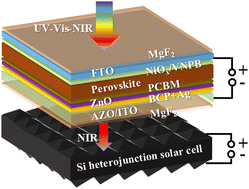Perovskite solar cells (PSCs) can be made semitransparent (ST) for more widespread applications, such as solar-powered vehicles, building-integrated photovoltaics (BIPV) and tandem devices. The most common ST-PSCs use sputtered transparent conductive oxides (TCO) as electrodes, and their power-conversion efficiencies (PCEs) lag behind those of opaque devices due to the detrimental deposition process of the transparent electrodes. In most cases, to reduce the sputtering damage, a metal oxide buffer layer is deposited before sputtering to protect the organic carrier-transport layer. Theoretically, compared with an individual buffer, a multi-layer buffer can be more helpful in performance improvement. Here, we designed a ZnO/BCP/Ag multi-layer buffer with an improved performance compared with the single ZnO layer buffer. By replacing the single-layer ZnO with the ZnO/BCP/Ag multi-layer buffer, the PCE of ST-PSC was improved from 7.88% to 16.14%, and the fill factor (FF) increased from 37.42% to 67.46%. After adding a metal frame for carrier collection, a small-area ST-PSC achieved an optimal PCE of 17.95%. By combining this ST-PSC with a silicon solar cell, a four-terminal perovskite/silicon tandem cell with a PCE of 26.18% was obtained.

